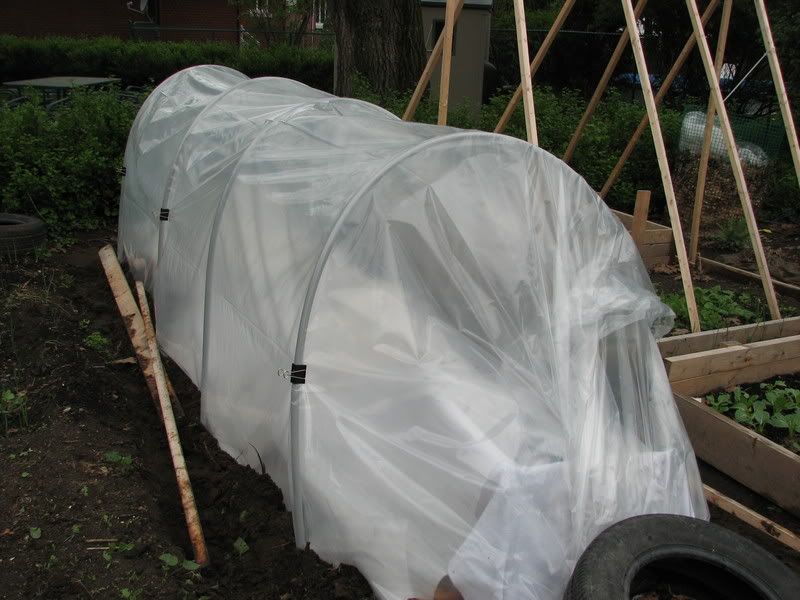
Today, a low of 2-3 C is expected with a windchill making that feel like a much more nippy -2C.
That's right my friends (and tomatoes), below 0.
A little lesson on frost:
Hortiphilia Fact
Four (degrees celcius) or less
(Frost tender) plants become a mess!
Few know (myself included until recently) that temperature is measured from about a height of 5 feet. As cold air sinks, the temperature at ground level can be much colder than that, like 0 degrees. Frost happens when the temperature is freezing - shock and surprise - so a measurement of 3 or 4 degrees, though above 0, may still mean frost for your plants.
Other factors that affect whether or not there will be a frost is how still the air is. A breeze, can keep the air circulating so that cold air doesn't have time to settle out.
4 degrees predicted? Will there be frost?
1. Cloudy weather: less chance.
2. Clear skies: more chance.
3. Rain: Less chance.
4. Snow: Draw your own conclusions.
5. Stiff breeze: Less chance.
6. Raised beds: Less chance.
7. Dry air: more chance
8. Cold air barrier: more chance
9. Moist packed soil: less chance
10. Loose (recently cultivated), dry soil: more chance
When in doubt, don't put it out.
or...
If it's in bed, cover its head.
How to protect plants
The sad truth, from my research, seems to be that most row covers / hot caps / polytunnels and the like only give about 2-4 degrees of frost protection. However, that can be quite significant if you are expecting a nightime temp of around 3 degrees. It could mean the difference between plant death and plant dismay.
You can use pretty much anything to cover plants in a pinch such as an overturned pot, cardboard box, old towel, blanket, an impromptu coldframe constructed out of hay barrels or other supports and some sort of light such as an old storm window or plastic sheeting.
You can also use more classic products such as a hot cap, or polytunnel, but apply these before dusk as much of the frost protection comes from the microclimate created inside. Heat is stored by pots, the ground etc... inside the polytunnel and then radiated back out at night.
Caution: Make sure your plants don't overheat which is easier than you may think in a polytunnel on a warm day. Raise the sides, open the ends, otherwise ventilate.
Floating row cover is also an option but again it only gives you a couple of degrees of frost protection. It will be more affective if it doesn't actually touch the plants. This can be accomplished by hoops such as the polytunnel or by jabbing sticks into the ground so that the floating cover tents out above the plant. Primarily, the advantage of row covers is to provide a protected environment to speed along the growth of young plants or to keep out pests.
Stay tuned for more on whether the plants will weather the weather.
Each day they live, I will find another exciting frost fact to post.
Links:
Great discussion on frost - aimed at strawberry growers but very useful to all.
Discussion on polytunnels - by a manufacturer

1 comment:
Gee, this seems like a lot of work! I know I wouldn't bother doing all this, but then my tomatoes are getting way too large sitting inside my house wondering when they can be set free outside. Good luck on avoiding the deadly frosts!
Post a Comment